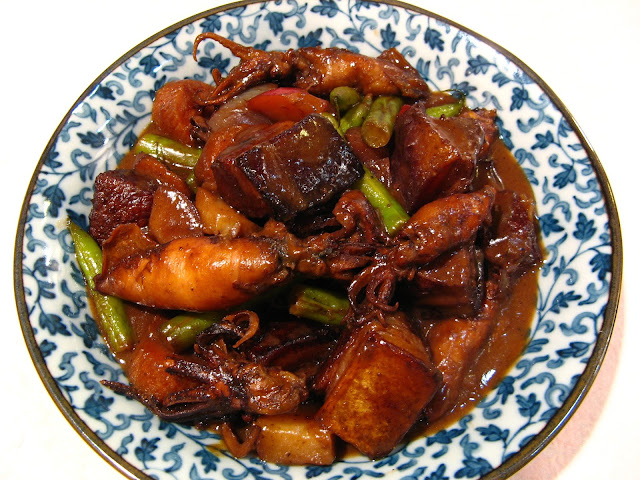While this recipe would seem to be more appropriate during
the winter, it is still tasty when cooked during the summer, especially when
you use a slow cooker (i.e. crockpot) to make the dish. Fresh lotus root is probably
not in season during the summer, since I couldn’t find it at any of my local
Asian markets. So pre-cut frozen lotus root makes a good substitute when fresh
is not available (and then even the frozen lotus root slices can sometimes be
hard to find). If lotus root cannot be found, daikon makes a good substitute.
Beef banana shank and beef tendon go together to make a
classic Chinese stew. This dish is very similar to the Beef Shank and Tendon Stew (燜牛筋牛腱, Man1
Ngau4 Gan1 Ngau4 Gin3) recipe. The
difference between the recipes being, of course, the addition of Madras Curry
Paste to the dish. Madras Curry Paste can be purchased at your local Asian
market, or you can make your own by mixing Madras Curry Powder with a neutral
oil to make a slurry. Chee Hou sauce is also an important ingredient to making
this dish. Chee Hou sauce is a prepared sauce and is similar in taste to hoisin
sauce (which can be substituted if you can’t find it at your local Asian market)
and has a slightly spicier taste to it.
Boneless beef banana shank is usually prepared and served as
a cold dish appetizer at Chinese banquets, in a very similar preparation as for
this stew dish. This cut of meat is usually not available at your local market,
but can be found in Asian markets. If you can’t find beef banana shank, beef
outside flank makes a good substitute. Beef tendon is another part of the cow
available at Asian markets either whole or already cut into pieces. It’s a
texture ingredient that produces a great mouth feel when eaten. Uncooked, it’s
tough and hard to cut, cooked long and slow, and it becomes soft. There’s
really no substitute for this ingredient, so if you can’t find it, it can be
omitted, but the stew won’t be the same.
Enjoy!



















